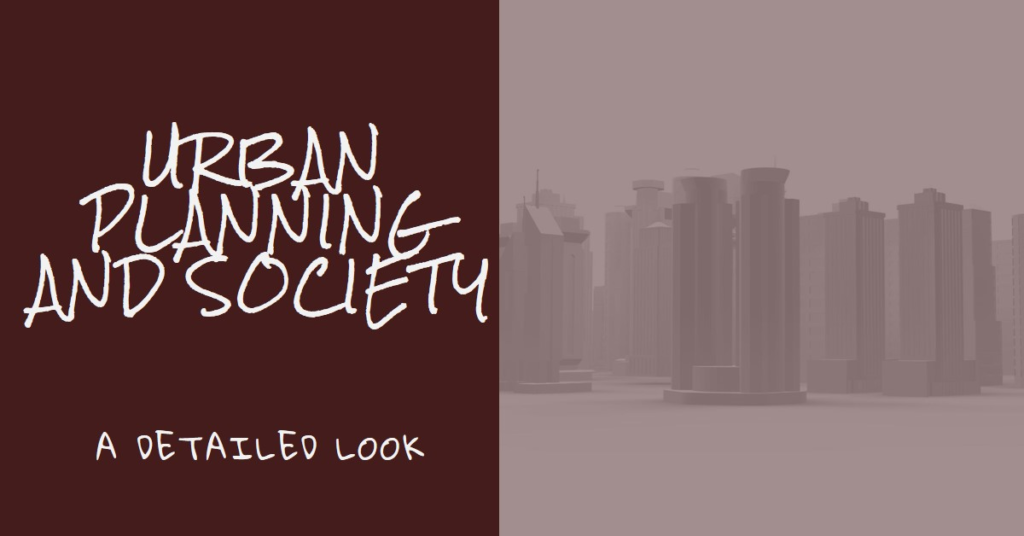
Table of Contents
- Introduction:
- The Foundation of Urban Planning:
- Economic Impact of Urban Planning:
- Enhancing Quality of Life:
- Environmental Sustainability:
- Social Equity and Inclusion:
- Public Health and Safety:
- Transportation and Mobility:
- Cultural and Historical Preservation:
- Community Engagement and Participation:
- Conclusion: The Future of Urban Planning
Introduction:
Urban planning shapes the very fabric of our daily lives. It defines where we live, work, and play, and influences our environment, economy, and social interactions. The importance of urban planning cannot be overstated, as it determines the functionality and sustainability of cities. This detailed exploration will examine various aspects of urban planning and its profound effects on society.
The Foundation of Urban Planning:
Urban planning is the process by which cities are designed and regulated. It encompasses everything from zoning laws to the placement of parks and transportation systems. At its core, urban planning aims to create functional, efficient, and aesthetically pleasing urban environments.
A well-planned city considers both current and future needs. It balances residential, commercial, and industrial areas while ensuring adequate public spaces and green areas. The foundation of urban planning is laid with comprehensive plans that integrate various aspects of city life, addressing issues like traffic congestion, housing shortages, and environmental sustainability.
Economic Impact of Urban Planning:
Urban planning significantly influences a city’s economic health. Proper planning can attract businesses, create jobs, and stimulate economic growth. By strategically zoning areas for commercial use, planners can encourage the development of shopping districts, business hubs, and industrial parks.
Moreover, efficient transportation systems designed through urban planning reduce travel time and costs, enhancing productivity. Infrastructure improvements, such as modernized public transit and well-maintained roads, make cities more attractive to both businesses and residents. Thus, urban planning directly contributes to economic vitality and competitiveness.
Enhancing Quality of Life:
Quality of life is a crucial measure of urban planning success. A well-planned city offers its residents safety, comfort, and convenience. Urban planners design neighborhoods to be livable, with accessible services and amenities. This includes everything from healthcare and education facilities to recreational parks and cultural centers.
Walkability is another key aspect of quality of life. Cities that prioritize pedestrian-friendly streetscapes promote healthier lifestyles and reduce reliance on automobiles. This not only improves physical health but also fosters social interactions and community cohesion, enriching the social fabric of the city.
Environmental Sustainability:
Sustainability is a cornerstone of modern urban planning. Cities are major consumers of resources and significant contributors to pollution and greenhouse gas emissions. Therefore, sustainable urban planning aims to minimize environmental impact through green building practices, energy-efficient infrastructure, and the preservation of natural areas.
Green spaces, such as parks and urban forests, are integral to sustainable cities. They improve air quality, provide recreational opportunities, and serve as habitats for wildlife. Moreover, integrating renewable energy sources and promoting public transportation reduces the urban carbon footprint, contributing to a healthier planet.
Social Equity and Inclusion:
Urban planning also addresses social equity and inclusion, ensuring that all residents have access to essential services and opportunities. Inclusive planning considers the needs of diverse populations, including low-income groups, minorities, and people with disabilities.
Affordable housing is a critical component of equitable urban planning. By zoning for mixed-income developments and providing incentives for affordable housing projects, cities can mitigate the effects of gentrification and prevent socio-economic segregation. Equitable access to public transportation, education, and healthcare services further enhances social inclusion.
Public Health and Safety:
Public health and safety are primary concerns in urban planning. Planners design cities to minimize health risks and enhance safety for all residents. This involves regulating building codes, ensuring proper sanitation, and creating safe public spaces.
The built environment significantly impacts physical and mental health. Access to green spaces, clean air, and safe drinking water are essential for well-being. Additionally, urban planners implement strategies to reduce crime through environmental design, such as improved street lighting and community-oriented public spaces, thereby fostering a sense of security.


Transportation and Mobility:
Effective transportation planning is vital for urban mobility. Cities need efficient and reliable transportation networks to connect people and places. Urban planners design integrated systems that include roads, public transit, cycling paths, and pedestrian walkways.
Public transportation is a critical element of urban mobility. Well-designed transit systems reduce traffic congestion, lower greenhouse gas emissions, and provide affordable travel options. Furthermore, promoting alternative modes of transport, such as cycling and walking, helps alleviate urban sprawl and enhances connectivity within the city.
Cultural and Historical Preservation:
Urban planning also plays a role in preserving cultural and historical heritage. Cities are repositories of historical buildings, landmarks, and cultural sites that reflect their unique identities. Planners work to protect these assets while accommodating modern development.
Historic preservation efforts ensure that the cultural legacy of a city is not lost amidst new construction. This involves enforcing regulations that protect heritage sites and integrating them into contemporary urban landscapes. By doing so, urban planning helps maintain the cultural continuity and character of cities, enriching the urban experience.
Community Engagement and Participation:
Community engagement is essential for effective urban planning. Involving residents in the planning process ensures that the development meets the actual needs and desires of the community. Public consultations, workshops, and participatory planning sessions are tools that planners use to gather input and foster a sense of ownership among residents.
When communities are engaged in planning, the resulting projects are more likely to succeed. This collaborative approach not only enhances the quality of urban environments but also builds trust between residents and planners. Community involvement ensures that urban development is inclusive, responsive, and reflective of the people it serves.
Conclusion: The Future of Urban Planning
The future of urban planning lies in creating resilient, inclusive, and sustainable cities. As urbanization continues to accelerate, planners must adopt innovative approaches to address emerging challenges. Smart city technologies, for example, offer new possibilities for efficient resource management and improved quality of life. Urban planning will increasingly focus on resilience to climate change, fostering social equity, and integrating technological advancements. By prioritizing these goals, planners can create cities that are not only functional and attractive but also sustainable and inclusive for future generations.
In conclusion, urban planning is a multifaceted discipline with far-reaching impacts on society. It shapes our environments, influences our economies, and enhances our quality of life. As we look to the future, thoughtful and inclusive urban planning will be key to building vibrant, resilient, and equitable cities.



